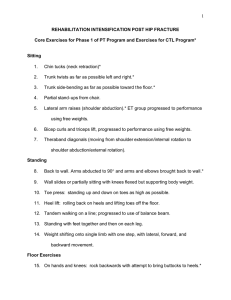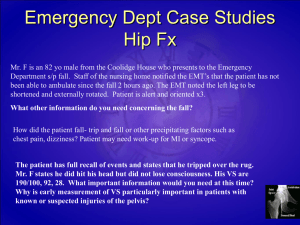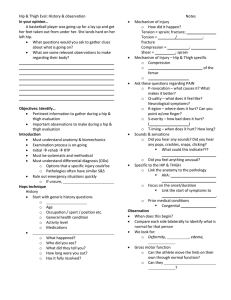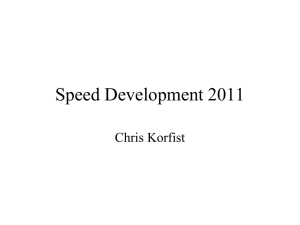Hip Exercise Considerations__xid-8566823_1
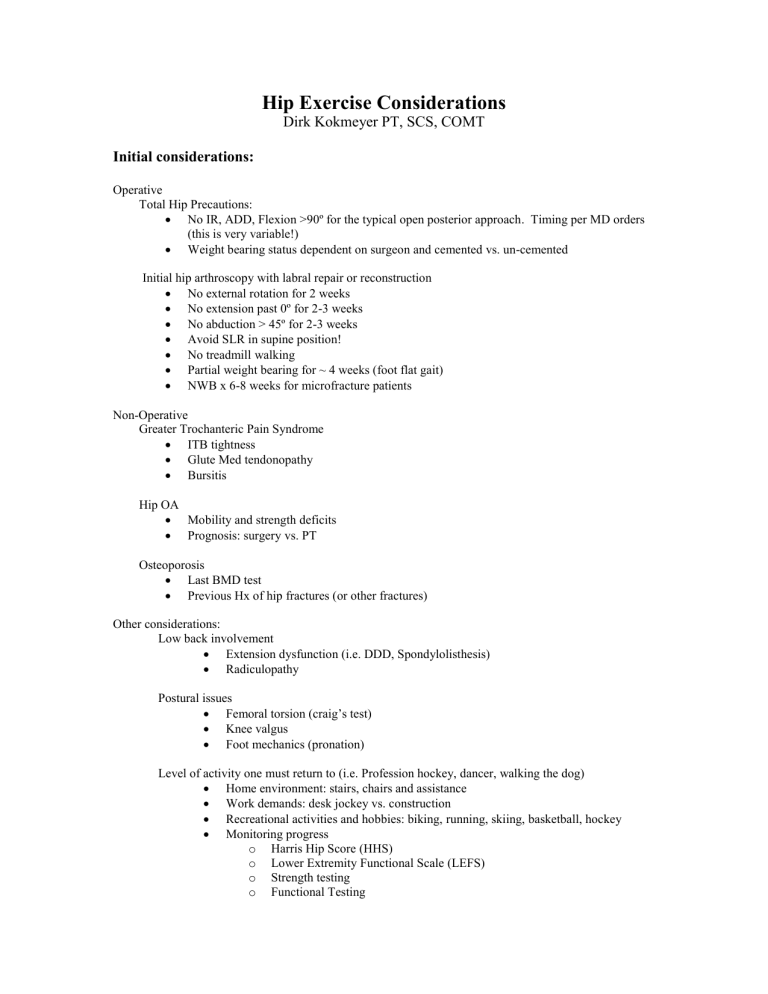
Hip Exercise Considerations
Dirk Kokmeyer PT, SCS, COMT
Initial considerations:
Operative
Total Hip Precautions:
No IR, ADD, Flexion >90º for the typical open posterior approach. Timing per MD orders
(this is very variable!)
Weight bearing status dependent on surgeon and cemented vs. un-cemented
Initial hip arthroscopy with labral repair or reconstruction
No external rotation for 2 weeks
No extension past 0º for 2-3 weeks
No abduction > 45º for 2-3 weeks
Avoid SLR in supine position!
No treadmill walking
Partial weight bearing for ~ 4 weeks (foot flat gait)
NWB x 6-8 weeks for microfracture patients
Non-Operative
Greater Trochanteric Pain Syndrome
ITB tightness
Glute Med tendonopathy
Bursitis
Hip OA
Mobility and strength deficits
Prognosis: surgery vs. PT
Osteoporosis
Last BMD test
Previous Hx of hip fractures (or other fractures)
Other considerations:
Low back involvement
Extension dysfunction (i.e. DDD, Spondylolisthesis)
Radiculopathy
Postural issues
Femoral torsion (craig’s test)
Knee valgus
Foot mechanics (pronation)
Level of activity one must return to (i.e. Profession hockey, dancer, walking the dog)
Home environment: stairs, chairs and assistance
Work demands: desk jockey vs. construction
Recreational activities and hobbies: biking, running, skiing, basketball, hockey
Monitoring progress o Harris Hip Score (HHS) o Lower Extremity Functional Scale (LEFS) o Strength testing o
Functional Testing
Initial Phase:
Goals:
1.
Restore mobility within parameters
2.
Maintain strength
3.
Decrease swelling
4.
Restore normal muscle balance
Mobility exercises
1.
Hip circumduction and PROM performed by therapist and instructed to patient and caregiver within parameters (Consider acetabular plane!!!) a.
ER (0º and 90º) b.
IR (0º and 90º) c.
ABD d.
Prone Extension e.
Flexion
2.
Quadruped rocking and cat/camel exercise
3.
Prone Press-up – for hip flexor and hip extension mobility a.
Progress to contralateral leg off table for greater stretch
4.
Supine contralateral knee to chest – rectus femoris hip flexor stretching
Early Strengthening
1.
Isometrics for 1-2 weeks depending on severity of condition a.
Glutes – prone heel squeeze b.
Abduction – Glute Medius c.
Transverse abdominus, lower abs d.
Quad – prone bolster e.
Hamstring isometrics f.
Prone ER/IR
2.
Active range of motion (light strength) a.
Stationary biking b.
Glute Med and Max progression (in ranking order according to EMG findings, Philippon et al AJSM 2011) i.
Supine ii.
Hip clam neutral iii.
Hip clam iv.
Sidelying abd on wall v.
Sidelying abd with ER vi.
Prone heel squeeze with hip extension vii.
Supine bridging (double leg) c.
Supine bridging on physio-ball (straight legs) d.
Quadruped kicks e.
Standing 3 way touch (hockey skaters) with Tabs f.
Stool rotations – IR and ER mobility
g.
Supine FABER/FADIR (Butterfly)
3.
Neuromuscular exercises (to progress into later phases as well) a.
Prone perturbations for ER, IR, Knee flexion and extension b.
Prone ER, IR (pendulum) with Tab c.
Add extension and hip flexion perturbations
Gait and beginning – intermediate strength phase:
Goals
1.
Restore normal gait
2.
Continue to improve/restore strength and mobility
3.
Progress patient to functional activity
4.
Restore normal alignment in a closed kinetic chain (i.e. dynamic valgus)
Gait Exercise progression (progress from pool to dry-land, if pool available to patient)
1.
Weight shifting progression a.
Side to side leans b.
Forward backward leans with involved foot in front or back
2.
Forward walk with Tab emphasis
3.
Backward walk with Glute/hip extension emphasis
4.
Side stepping
5.
Diagonal stepping
6.
Mini lunge (hip flexor stretch, increased quad activity)
7.
Ladder drill patterns
Mobility considerations
1.
Thomas test/stretch a.
Rectus assessment b.
Hip Flexor assessment – preferred position for stretch c.
ITB assessment
2.
Sidelying Thomas stretch a.
Hip extension stretch (add glute isometric) b.
ITB emphasis (hip adduction, knee flexion for distal ITB) c.
R. Femoris – knee flexion
3.
Prone quad stretch a.
Use combined extension mobilization for hip flexor stretch
4.
FABER stretch – consider posterior glide in the acetabular plane
5.
Adductor hypertonicity/guarding
Closed kinetic chain progressions – a transition to more advanced exercises
1.
Leg press (supine preferable) a.
Double leg b.
Single leg
2.
Squat progression (option: advance to Bosu with flat side up) a.
Begin with 75/25% weight bearing (shallow) b.
Advance to 50/50% weight bearing (shallow) c.
Progress to deeper squat d.
Advance to 25/75 (concentric) e.
Advance to 25/75 (concentric-eccentric) f.
Duration skier tucks
3.
Supine Bridging (option: stability exercise with dyna-disc or airex) a.
Double leg bridge (introduced in earlier phase) b.
Single leg bridge c.
Bridging on fit ball for hamstrings i.
Bridge with slightly bent knees ii.
Maintain bridge position and roll ball iii.
Single leg bridge on medicine ball
4.
3 point touch progression (hockey skater) – with band, dyna-disc or airex a.
3-point touch standing – involved leg touches b.
3-point touch – uninvolved leg touches (weight bearing on involved) c.
Advance to deep position, more excursion and timed sets d.
Side steps with band (monster walks)
5.
Other quality CKC exercises a.
Wall squats b.
Forward step-ups c.
Backward step-downs d.
Lateral step-ups e.
Romainian dead lifts (begin with table 3 way hand touch and progress) f.
Forward walking lunge with hip flexor stretch g.
Balance squats
Advanced Strength Phase – aka “ when can I run, ski, jump, play basketball, skateboard?”…..phase.
This phase may not be necessary for all patients depending on athletic demand
Goals:
Restore agility, muscular power, endurance and neuromuscular control
Pass functional testing standards, if applicable
Integrate patient to interval participation and eventually release to sports participation at a limited or full level. (consult with team physician, coach, trainer, etc.)
One example of criterion to advance to this phase (there are several…)
1.
Symmetrical isometric testing with hand held dynamometer
2.
3 minutes of skier tuck squats
3.
1 minute of single knee bends between 45-60º while maintaining adequate lower extremity alignment
4.
Minimal functional limitations on LEFS or HHS
5.
Minimal pain with the above criteria standards
Plyometric progressions – eccentric phase
amortization phase
concentric phase
1.
Beginning plyometrics – focus on deceleration a.
Shuttle leg press plyometrics or pilates reformer with plyo-back b.
Trampoline light jogs c.
Shallow double leg jump – land d.
Shallow box jump-ups e.
Jog into the wall exercise
2.
Intermediate exercises – integrate greater intensity with quicker amortization a.
Box jump-ups – higher box, deeper land b.
Lateral box step overs c.
High knee trampoline jogs d.
Doorjam touches
3.
Advanced – higher intensity eccentric and concentric force with quick amortization (Explosive!) a.
Forward sports cord jog b.
Backward sports cord jog c.
Lateral agility d.
Diagonal lateral agility e.
Box Jump down
land
jump up (for height) f.
Scissor kick plyo’s
Agility Drills
1.
Forward sprints to chop downs to backpedals
2.
Ladder drills
3.
Z-cuts
4.
W-cuts
5.
Kariokas (grapevines)
6.
Sports specific drills (basketball, soccer, football, etc) – see JOSPT April and
May 2012 issues for ideas for specific drills!
Functional Sports Test for the hip:
1.
3 minutes single knee bend with cord resistance
2.
100 seconds of lateral agility with sports cord
3.
100 seconds of diagonal lateral agility with sports cord
4.
2 minute box lunge
Patients are assessed for: pain, lower extremity mechanics, and ability to absorb impact. Passing this test is criteria to begin running and, in some cases return to sport drills.
